The unique stabilizer Calm Instab 500
I have in my hands the stabilizer “Stable Insta 500” , made especially for the project Lamptest.ru.
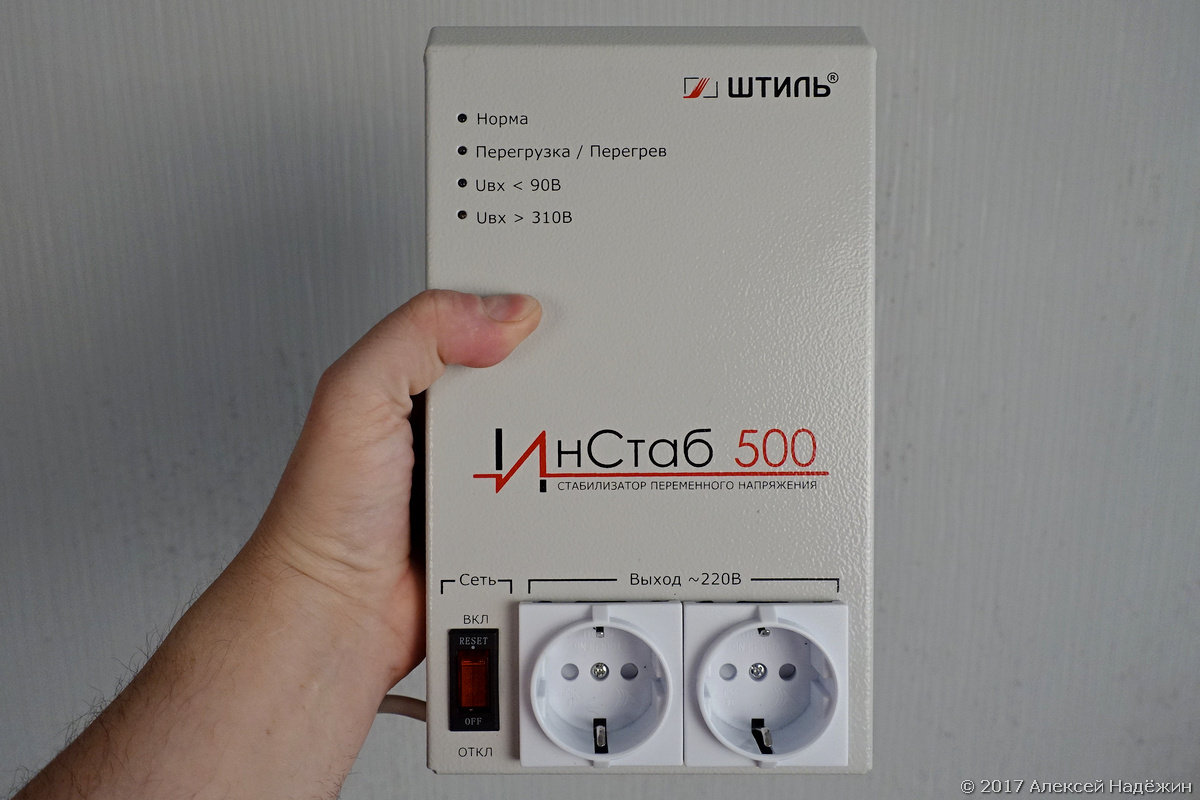
It produces a stable alternating voltage of 230 V with an accuracy of ± 0.6 V and its output voltage does not depend on the input voltage.
Line voltage stabilizers ( my article on stabilizers ) are used primarily where the quality of the mains voltage is low and the network often has a low or high voltage.
Almost all stabilizers on the market are of one of two types: step (relays or solid-state switches connect the load to one of several windings of the autotransformer) and electromechanical (the current collector moves along the winding of the autotransformer using a motor). For all stabilizers of these types, the output voltage depends on the input voltage, and if ordinary incandescent lamps are connected through the stabilizer, the brightness of their light will “twitch” when the input voltage jumps, despite the presence of a stabilizer.
')
The Russian company Shtil produces unique stabilizers operating on a different principle. These are double-conversion stabilizers: first, the mains voltage is rectified, and then the direct voltage is converted into a sinusoidal alternating voltage by means of an inverter, the level of which is completely independent of the input voltage, and besides, no interference from the network can reach the output.
According to the instructions, the stabilizer has an efficiency of 96%, the non-linear distortion coefficient at a linear load of 1.5%. At the same time, it is the "improver" of the power factor - regardless of the power factor (power factor) of the load, its power factor for the supply network is always 0.99.
To check the operation of the stabilizer, I connected it to the output of the LATRA - a laboratory autotransformer, which allows smoothly changing the alternating voltage over a wide range ( my article about it ). The voltage at the input and output of the stabilizer is controlled simultaneously by a digital and pointer instrument (voltage fluctuations are more clearly visible from the arrow's deflection). An ordinary incandescent lamp is connected to the output of the stabilizer.
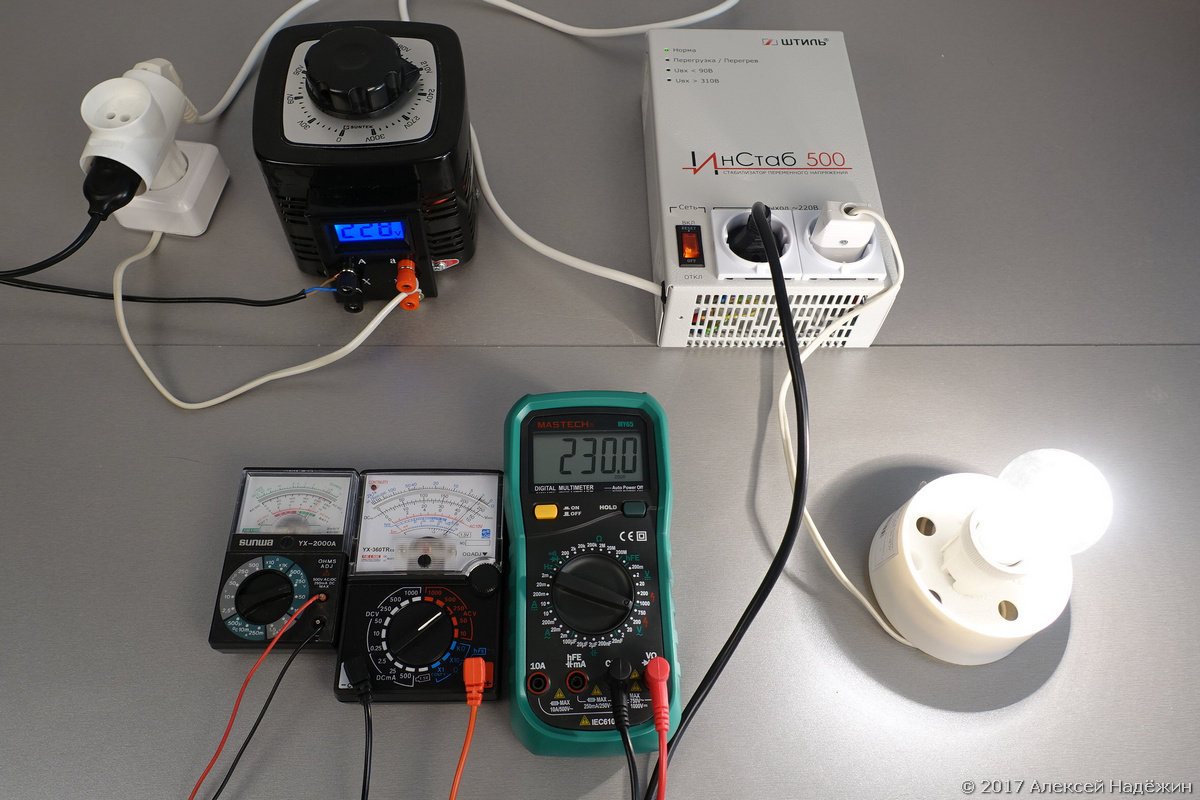
The stabilizer operates at an input voltage of 90-310 V. For any changes in the input voltage in this range (both smooth and intermittent), the output voltage does not change at all. Arrow voltmeter stands, rooted to the spot, the brightness of the lamp does not change.
For example, at the input of the stabilizer 95 V, and at the output 230.2 V.
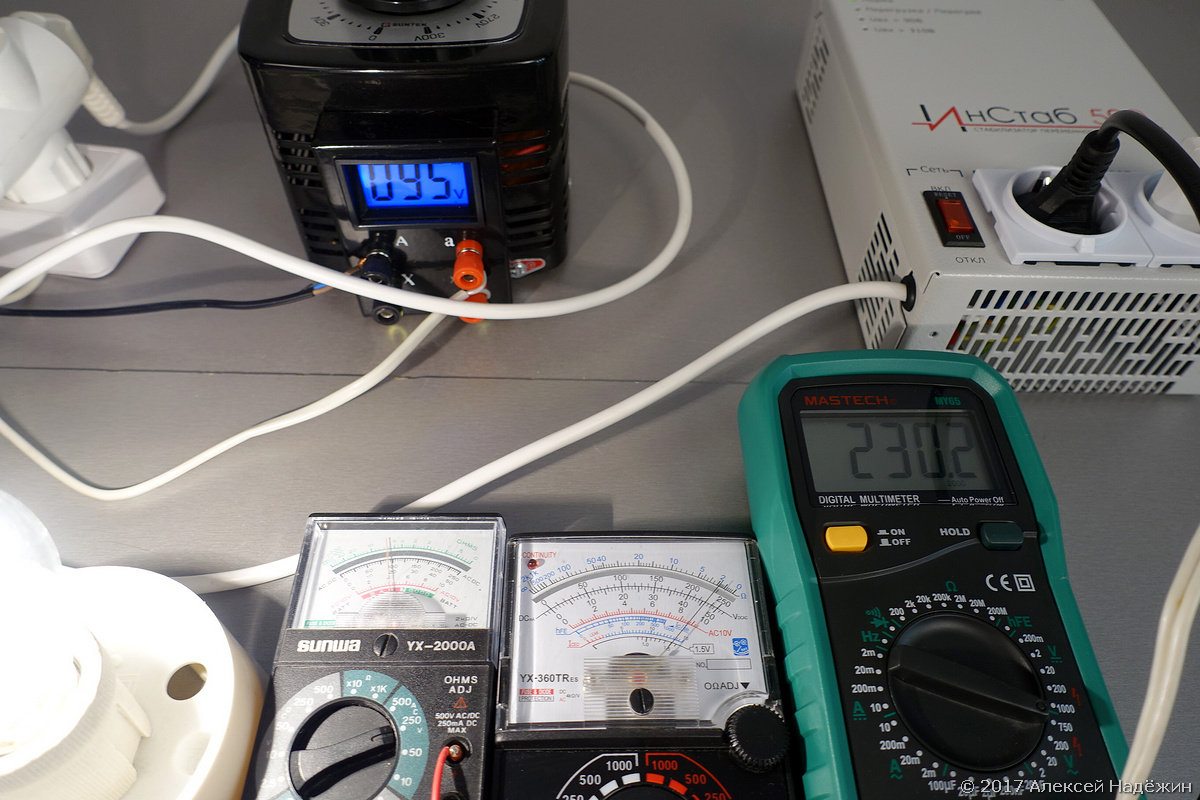
The output voltage varies slightly, but it does not depend on the input voltage, but on the processes in the stabilizer itself. The manufacturer is reinsured and indicates in the technical characteristics the accuracy of stabilization ± 2% (and at an output voltage of 220 V is ± 4.4 V), the actual voltage deviates from the nominal value by no more than 0.6 V (± 0.3%).
If the input voltage is out of stabilization, the stabilizer shuts off the load and one of the Uv <90V or Uin> 310 V indicators lights up on it.
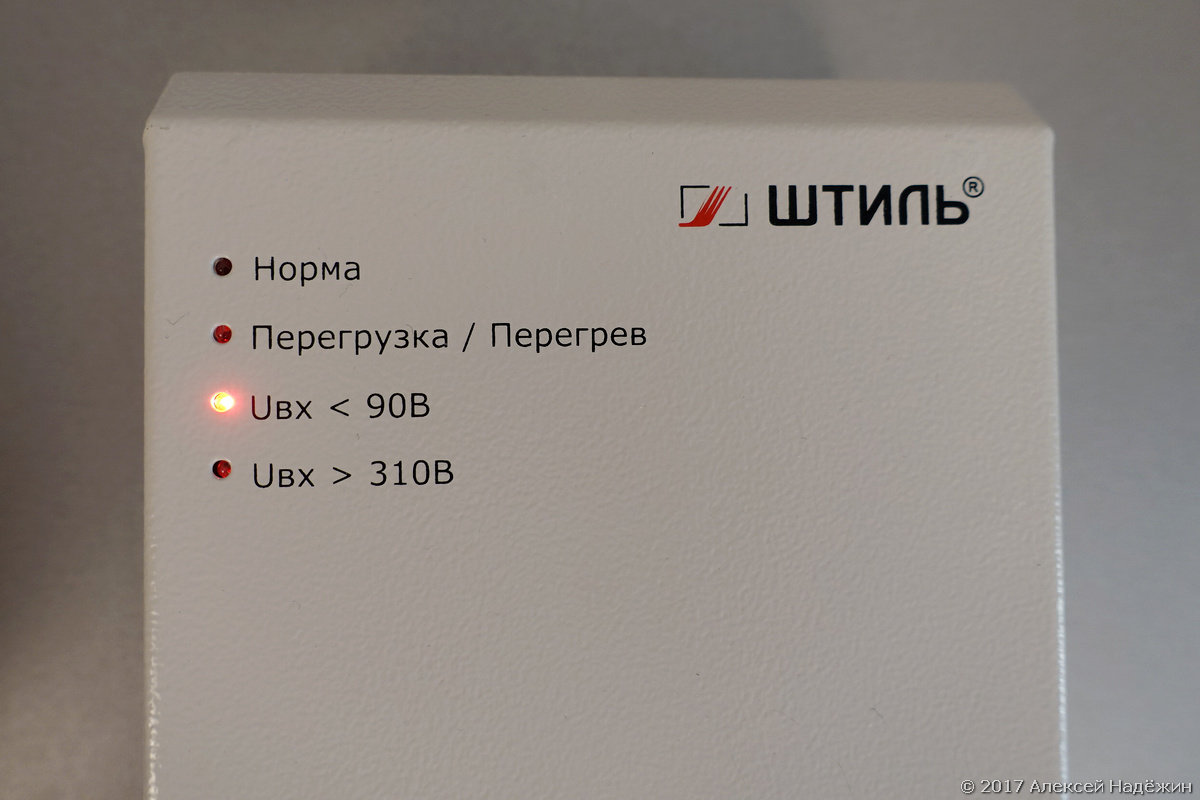
After returning the input voltage to acceptable limits, the stabilizer turns on again.
Upd.: Removed the waveform at the output of the stabilizer: a beautiful sine wave.
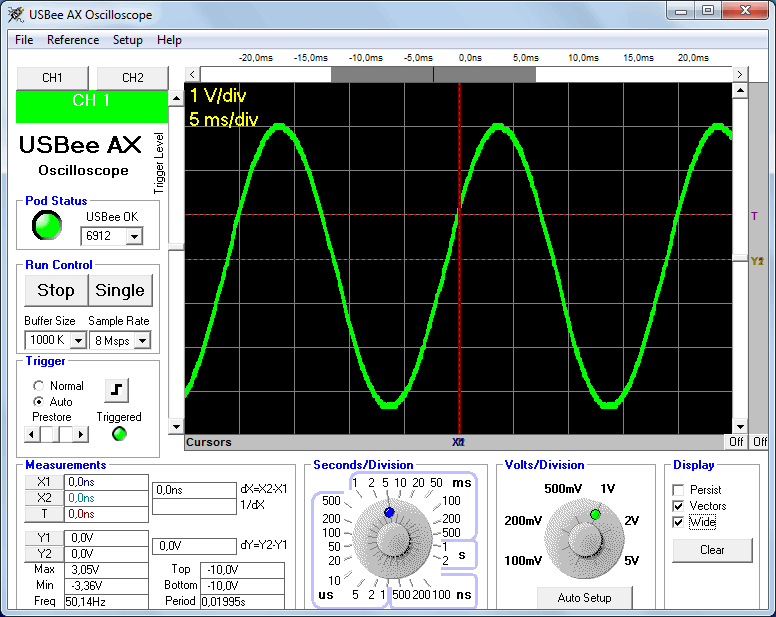
From changes in the input voltage, its shape does not change. When a reactive load is connected and disconnected, the sinusoid is sometimes distorted for a fraction of a second (short pulses appear on it). Fix the interference in the form of a screenshot failed.
This is how the stabilizer looks like with the cover removed.

The inverter is controlled by the processor board, protected from interference by a metal screen.
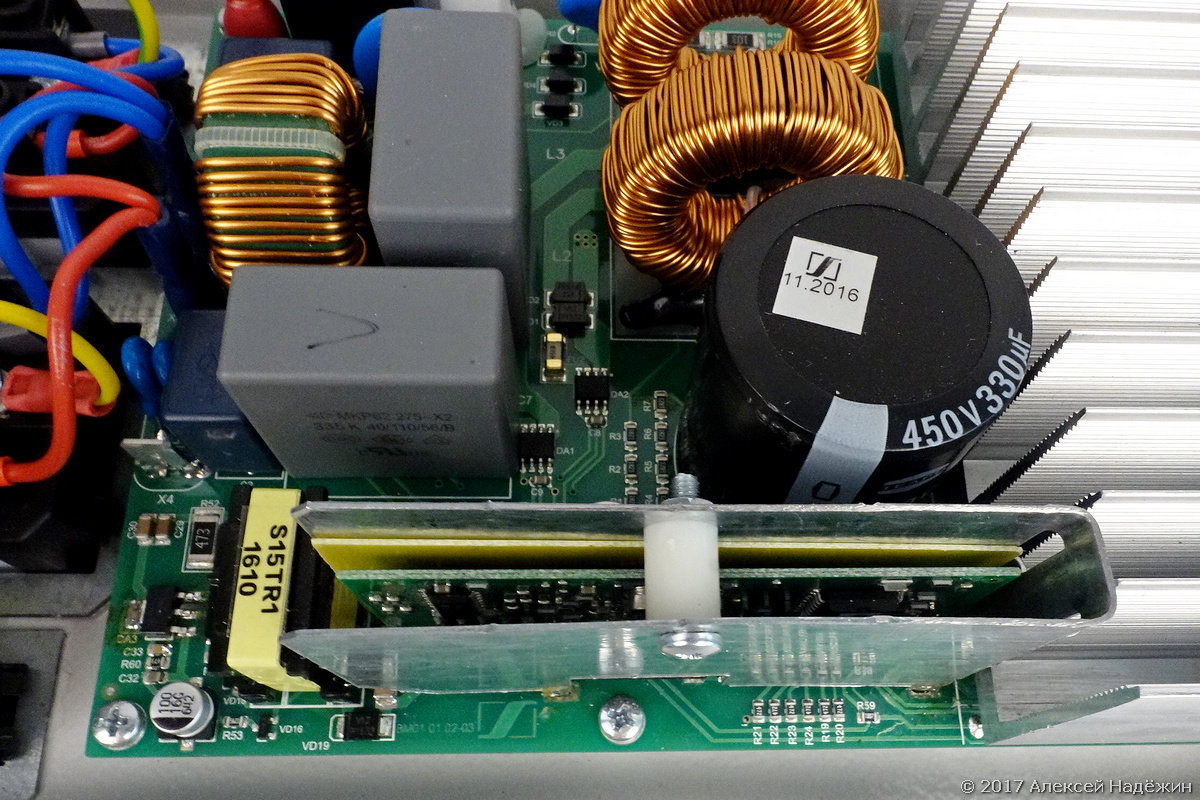
The voltage at the output of the stabilizer is regulated only by the parameters in the firmware. Now available stabilizers with an output voltage of 220 V, and my stabilizer with a voltage of 230 V was made in a single copy. Closer to the summer it is planned to arrange the release of stabilizers with the possibility of selecting the output voltage of 220/230 V.
I shot a video clearly demonstrating the work of the stabilizer.
In the Instab series, there are four stabilizers with an output of 500, 1000, 1500 and 3500 VA, but only the Instab 500 has no fan and is almost silent. Almost, because the stabilizer emits a quiet, itchy sound, almost unheard at a distance of a meter from the stabilizer body.
An instab 500 costs 6396 rubles, an instab 1000 - 10956 rubles, an instab 1500 - 12949 rubles, an instab 3500 - 22649 rubles.
Calm also produces automotive inverters with a capacity of 300 W / 450 VA, which are three times larger in size and weight than Chinese inverters with the same declared power. And this is no accident. Inverters Calm PS12-300A and PS24-300A provide pure sine wave, withstand overload up to 105% - long, 105-125% - 60 s, 125-170% - 8c,> 170% - 3c and have all possible protection, though they stand at this 7,500 rubles.
In general, the company's main business is the production of industrial inverters, UPS and power supply installations. Their equipment is located on the set of base stations of cellular operators.
Apparently, Calm is the only manufacturer of household inverter stabilizers in the world. It is possible that something similar is for professional use, but I could not find other household stabilizers working on this principle.
Stabilizers are designed and manufactured in Russia at the plant in Tula.
Thanks to the company Shtil and personally General Director of Shtil LLC Sergey Pavlov for the stabilizer, thanks to which the measurements of Lamptest.ru have become even more precise.
© 2017, Alexey Nadyozhin

It produces a stable alternating voltage of 230 V with an accuracy of ± 0.6 V and its output voltage does not depend on the input voltage.
Line voltage stabilizers ( my article on stabilizers ) are used primarily where the quality of the mains voltage is low and the network often has a low or high voltage.
Almost all stabilizers on the market are of one of two types: step (relays or solid-state switches connect the load to one of several windings of the autotransformer) and electromechanical (the current collector moves along the winding of the autotransformer using a motor). For all stabilizers of these types, the output voltage depends on the input voltage, and if ordinary incandescent lamps are connected through the stabilizer, the brightness of their light will “twitch” when the input voltage jumps, despite the presence of a stabilizer.
')
The Russian company Shtil produces unique stabilizers operating on a different principle. These are double-conversion stabilizers: first, the mains voltage is rectified, and then the direct voltage is converted into a sinusoidal alternating voltage by means of an inverter, the level of which is completely independent of the input voltage, and besides, no interference from the network can reach the output.
According to the instructions, the stabilizer has an efficiency of 96%, the non-linear distortion coefficient at a linear load of 1.5%. At the same time, it is the "improver" of the power factor - regardless of the power factor (power factor) of the load, its power factor for the supply network is always 0.99.
To check the operation of the stabilizer, I connected it to the output of the LATRA - a laboratory autotransformer, which allows smoothly changing the alternating voltage over a wide range ( my article about it ). The voltage at the input and output of the stabilizer is controlled simultaneously by a digital and pointer instrument (voltage fluctuations are more clearly visible from the arrow's deflection). An ordinary incandescent lamp is connected to the output of the stabilizer.

The stabilizer operates at an input voltage of 90-310 V. For any changes in the input voltage in this range (both smooth and intermittent), the output voltage does not change at all. Arrow voltmeter stands, rooted to the spot, the brightness of the lamp does not change.
For example, at the input of the stabilizer 95 V, and at the output 230.2 V.

The output voltage varies slightly, but it does not depend on the input voltage, but on the processes in the stabilizer itself. The manufacturer is reinsured and indicates in the technical characteristics the accuracy of stabilization ± 2% (and at an output voltage of 220 V is ± 4.4 V), the actual voltage deviates from the nominal value by no more than 0.6 V (± 0.3%).
If the input voltage is out of stabilization, the stabilizer shuts off the load and one of the Uv <90V or Uin> 310 V indicators lights up on it.

After returning the input voltage to acceptable limits, the stabilizer turns on again.
Upd.: Removed the waveform at the output of the stabilizer: a beautiful sine wave.

From changes in the input voltage, its shape does not change. When a reactive load is connected and disconnected, the sinusoid is sometimes distorted for a fraction of a second (short pulses appear on it). Fix the interference in the form of a screenshot failed.
This is how the stabilizer looks like with the cover removed.

The inverter is controlled by the processor board, protected from interference by a metal screen.

The voltage at the output of the stabilizer is regulated only by the parameters in the firmware. Now available stabilizers with an output voltage of 220 V, and my stabilizer with a voltage of 230 V was made in a single copy. Closer to the summer it is planned to arrange the release of stabilizers with the possibility of selecting the output voltage of 220/230 V.
I shot a video clearly demonstrating the work of the stabilizer.
In the Instab series, there are four stabilizers with an output of 500, 1000, 1500 and 3500 VA, but only the Instab 500 has no fan and is almost silent. Almost, because the stabilizer emits a quiet, itchy sound, almost unheard at a distance of a meter from the stabilizer body.
An instab 500 costs 6396 rubles, an instab 1000 - 10956 rubles, an instab 1500 - 12949 rubles, an instab 3500 - 22649 rubles.
Calm also produces automotive inverters with a capacity of 300 W / 450 VA, which are three times larger in size and weight than Chinese inverters with the same declared power. And this is no accident. Inverters Calm PS12-300A and PS24-300A provide pure sine wave, withstand overload up to 105% - long, 105-125% - 60 s, 125-170% - 8c,> 170% - 3c and have all possible protection, though they stand at this 7,500 rubles.
In general, the company's main business is the production of industrial inverters, UPS and power supply installations. Their equipment is located on the set of base stations of cellular operators.
Apparently, Calm is the only manufacturer of household inverter stabilizers in the world. It is possible that something similar is for professional use, but I could not find other household stabilizers working on this principle.
Stabilizers are designed and manufactured in Russia at the plant in Tula.
Thanks to the company Shtil and personally General Director of Shtil LLC Sergey Pavlov for the stabilizer, thanks to which the measurements of Lamptest.ru have become even more precise.
© 2017, Alexey Nadyozhin
Source: https://habr.com/ru/post/401209/
All Articles